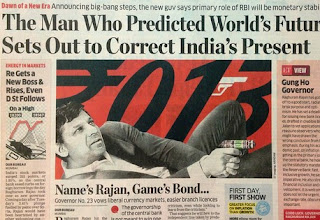The James Bond tag hit the world's headlines when he was depicted as 007 in an image published in India's Economic Times. The illustration, based on a poster used for Skyfall, showed Rajan with gun poised, ready to defend India's currency (the gun is covered with rupees). The caption below the illustration read 'Name's Rajan, Game's Bond'. Rajan has also been called 'Bond of Mint Street', and may have played on this when he once told reporters that 'My name is Rajan and I do what I do.'
 |
| Raghuram Rajan as Bond, according to the Economic Times |
Had he known that banking could be so adventurous and action-packed, perhaps Ian Fleming would have been tempted to give his short banking career (he spent a year at merchant bankers, Cull and Co.) a longer run!


